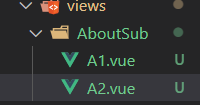1.动态路由配置?
前期准备:
通过 vue create xxx 创建vue项目,这里在创建时我们勾选上 router 选项,自动创建路由
将前面学习 axios 时封装的跨域配置,utils文件夹以及 vue.config.js文件分别放置在该项目的src目录和根目录下
通过 npm install axios --save 安装 axios
项目结构:

?vue.config.js
module.exports = {
devServer: {
proxy: {
'/api': {
target: 'http://iwenwiki.com',
changeOrigin: true,
pathRewrite: { // 路径重写
"^/api": ""
}
}
}
}
}?src/utils/request.js
import axios from "axios"
import qs from "querystring"
/**
* 处理错误信息
* status:状态吗
* info:具体信息
*/
const errorHandle = (status,info) =>{
switch(status){
case 400:
console.log("语义错误");
break;
case 401:
console.log("服务器认证失败");
break;
case 403:
console.log("服务器请求拒绝执行");
break;
case 404:
console.log("请检查网路请求地址");
break;
case 500:
console.log("服务器发生意外");
break;
case 502:
console.log("服务器无响应");
break;
default:
console.log(info);
break;
}
}
/**
* 创建Axios对象
*/
const instance = axios.create({
// 公共配置
// baseURL:"http://iwenwiki.com",
timeout:5000,
// withCredentials: true
})
/**
* 拦截器
*/
instance.interceptors.request.use(
config =>{
if(config.method === 'post'){
// token:登陆信息凭证
config.data = qs.stringify(config.data)
}
return config
},
error => Promise.reject(error)
)
instance.interceptors.response.use(
// 完成了
response => response.status === 200 ? Promise.resolve(response) : Promise.reject(response),
error =>{
// 错误信息的处理
const { response } = error;
if(response){
errorHandle(response.status,response.info)
}else{
console.log("网络请求被中断了");
}
}
)
// get和post等请求方案
export default instanceApp.vue
<template>
<div id="app">
<div id="nav">
<router-link to="/">Home</router-link> |
<router-link to="/about">About</router-link>
</div>
<router-view/>
</div>
</template>
<style>
#app {
font-family: Avenir, Helvetica, Arial, sans-serif;
-webkit-font-smoothing: antialiased;
-moz-osx-font-smoothing: grayscale;
text-align: center;
color: #2c3e50;
}
#nav {
padding: 30px;
}
#nav a {
font-weight: bold;
color: #2c3e50;
}
#nav a.router-link-exact-active {
color: #42b983;
}
</style>
src/views/Home.vue
<template>
<div class="home">
<ListView />
</div>
</template>
<script>
import ListView from "../components/ListView.vue"
export default {
name: 'Home',
components: {
ListView
}
}
</script>
src/views/About.vue
<template>
<div class="about">
<h1>This is an about page</h1>
</div>
</template>
src/views/NotFound.vue
<template>
<div>
<h3>404</h3>
</div>
</template>
<script>
export default {
}
</script>
<style>
</style>src/views/Details.vue
<template>
<div>
<h3>详情页</h3>
<p>id={{$route.params.id}}</p>
<div>
<p>{{detailsData.desc}}</p>
</div>
</div>
</template>
<script>
import api from "../api"
export default {
data () {
return {
detailsData:{}
}
},
mounted () {
api.getDetails({
id:this.$route.params.id
}).then(res=>{
// console.log(res.data);
this.detailsData = res.data;
}).catch(error=>{
console.log(error);
})
}
}
</script>
<style>
</style>components/ListView.vue
<template>
<div>
<ul>
<li v-for="(item,index) in lists" :key="index">
<!--
点击实现跳转到相应的详情页面
1.在views里新建Details文件来展示详情页数据
2.在router/index.js里进行配置
-->
<router-link :to="'/details/'+item.id">
<div>
<p>{{item.title}}</p>
<img :src="item.cover" alt="">
<p>{{item.username}}</p>
</div>
</router-link>
</li>
</ul>
</div>
</template>
<script>
import api from "../api"
export default {
data () {
return {
lists:[]
}
},
mounted () {
api.getList().then(res=>{
// console.log(res.data);
if(res.data.result === "ok"){
this.lists = res.data.data;
}
}).catch(error=>{
console.log(error);
})
}
}
</script>
<style scoped>
ul,ol,li{
list-style: none;
}
ul li {
border-bottom: 2px solid #222;
}
img{
width: 100%;
}
</style>src/api/index.js
import axios from "../utils/request"
const base = {
baseUrl: '/api',
list: '/api/FingerUnion/list.php',
details: '/api/FingerUnion/details.php'
};
const api = {
/**
* 获得 list 数据
*/
getList() {
return axios.get(base.baseUrl + base.list);
},
getDetails(params) {
return axios.get(base.baseUrl + base.details, {
params
});
}
}
export default api;src/router/index.js
import Vue from 'vue'
import VueRouter from 'vue-router'
import Home from '../views/Home.vue'
Vue.use(VueRouter)
const routes = [{
path: '/',
name: 'Home',
component: Home
},
{
path: '/about',
name: 'About',
component: () =>
import ( /* webpackChunkName: "about" */ '../views/About.vue')
},
{
path: '/details/:id',
name: 'Details',
component: () =>
import ( /* webpackChunkName: "about" */ '../views/Details.vue')
},
{
path: '*',
name: 'NotFound',
component: () =>
import ( /* webpackChunkName: "about" */ '../views/NotFound.vue')
}
]
const router = new VueRouter({
mode: 'history',
base: process.env.BASE_URL,
routes
})
export default routermain.js
import Vue from 'vue'
import App from './App.vue'
import './registerServiceWorker'
import router from './router'
Vue.config.productionTip = false
new Vue({
router,
render: h => h(App)
}).$mount('#app')

点击跳转:
 ?
?
?
?
2.嵌套路由
About页面又嵌套了好几个页面
在上面的基础之上,在views目录下新建AboutSub文件夹:

?在src/router/index.js文件里对about路由做如下修改:
{
path: '/about',
name: 'About',
component: () =>
import ( /* webpackChunkName: "about" */ '../views/About.vue'),
children: [{
path: 'a1', //about/a1
name: 'A1',
component: () =>
import ( /* webpackChunkName: "about" */ '../views/AboutSub/A1.vue')
/*children:[]作为3级页面*/
},
{
path: 'a2', //about/a2
name: 'A2',
component: () =>
import ( /* webpackChunkName: "about" */ '../views/AboutSub/A2.vue')
}
]
},src/views/About.vue
<template>
<div class="about">
<h1>This is an about page</h1>
<div>
<router-link to="/about/a1">A1</router-link> |
<router-link to="/about/a2">A2</router-link>
</div>
<router-view></router-view>
</div>
</template>
src/views/AboutSub/A1.vue
<template>
<div>
<h3>A1页面</h3>
</div>
</template>
<script>
export default {
}
</script>
<style>
</style>src/views/AboutSub/A2.vue
<template>
<div>
<h3>A2页面</h3>
</div>
</template>
<script>
export default {
}
</script>
<style>
</style>
 ?
?
 ?
?
?
?
?
?